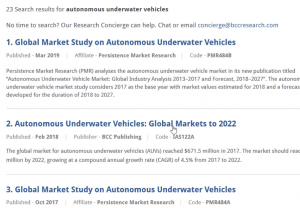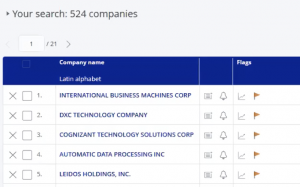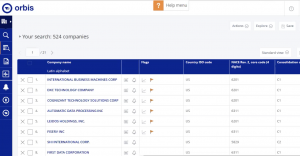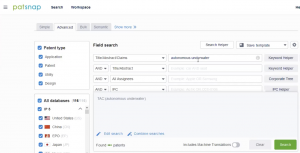Project Description
Master Classes are deep dives into venture creation by MIT ecosystem thought leaders. Browse all Master Classes Here.
This master class is partly based on the Orbit Knowledgebase section on secondary market research, and partly based on a talk that Nick Albaugh, the innovation librarian at the MIT Sloan School of Management gave in June 2020 at MIT.
Doing secondary market research at MIT
Market sizing is more art than science. Even analysts who do this professionally have to take educated guesses based on available statistics, which may not exactly answer the questions you are trying to pose.
To get started, you often need to collect a few numbers to anchor your estimation process. Common numbers you need include the market size and growth rate of specific industry segments. With a few citable numbers, you can start interpolating and extrapolating. But where might these numbers come from?
The following sections will help answer this question and guide you through how you might conduct a search to learn more about an industry segment, a company, existing patents on a particular technology and more.
First things first: Getting access to analyst portals via the MIT library system
Current students, staff members and faculty members of MIT have access to the MIT library system.
The MIT Libraries has subscriptions with several major analyst databases that cover a broad range of industries, including BBC Research, Gartner, Forrester and more. These are highly respected, highly citable reports that people in the industry pay tens of thousands of dollars for. If you are an enrolled student and need to do market sizing, you should definitely leverage this amazing resource while you can. Your access will end when you graduate or otherwise depart from MIT.
To use this wonderful resource, visit https://libguides.mit.edu/innovation.
Please respect the policies that make this resource available to you. Here is the MIT use policy as of June 2020.
“The Massachusetts Institute of Technology is an independent, private university. Institute facilities, including the Libraries, have the primary purpose of supporting MIT’s educational and research programs. The MIT Libraries may also serve the local community, the nation, and the world through the use of Libraries facilities, particularly when there is a compelling need or interest that can be met without detriment to the Institute’s primary purpose.
Access to and use of the MIT Libraries is a privilege extended to the members of the MIT community of faculty, students, and staff; including members of their immediate families and sponsored affiliates. Access to MIT Libraries’ facilities, services, and resources by visitors is limited to meeting a specific need for the scholarly, research, or educational materials and services available in the MIT Libraries.”
Analyst reports from these portals should never be forwarded or shared with people outside the above description.
Conducting secondary market research for market sizing and analysis
There are a lot of common questions that come up from the entrepreneurship ecosystem. By and large most questions have to do with market research. Entrepreneurs want to understand the size of the market they are getting into, is it growing or shrinking, who are the major players, what are the projections, how is the market broken down by segment and geography. These are the types of things that can be found in market research.
Typically, students will start with Googling their product or service. Generally the research guides they find are things that we will not have access to because they typically cost a minimum of $2000 – $75,000. They are sold 1×1 from analyst to consumers. MIT cannot purchase these resources. Instead of buying reports one at a time, MIT subscribes to multiple analyst portals that together, cover the majority of sectors that MIT students are interested in.
Different analysts focus on different sectors and industries. In order to focus your secondary market research, you need to know which analyst covers your sector. Following are a list of analyst portals accessible via https://libguides.mit.edu/innovation as of June 2020 for eligible students, staff and faculty members.
- BCC Research
Provides b2b market research reports with statistical and analytical information on industry structure, major players and their market shares, industry dynamics, forecast, and international developments relevant to the field. - IBIS World
IBIS World is a database that provides research reports on industries in the United States, the United Kingdom, Australia and China. Global industry reports for selected industries are also available. - Frost & Sullivan
Market research reports on Healthcare; Aerospace & Defense; Automotive & Transportation; Chemicals, Materials & Food; Electronics & Security; Energy & Power Supplies; Environment & Building Technologies; Industrial Automation & Process Control; Information & Communication Technologies; Measurement & Instrumentation. Coverage is both US and Global. - Forrester Research
Forrester’s research publications analyze a broad range of technology areas such as new media, computing, software, networking, telecommunications and the Internet, and project how technology trends will affect businesses, consumers, and society. - Gartner Group Reports
A great resource for B2B research and analysis of the impact of IT in Financial Services, Health Care, Government, Higher Education and Small and Medium sized business. - Passport Global Market Information Database (GMID)
Market research data from Euromonitor for 210 countries & 27 industries, including: market sizes, market data & forecasts, consumer lifestyles, companies and brands, economic indicators, demographic data, foreign trade statistics, and more. - Fitch Connect
Provides in-depth reports on 24 industries and 200 global markets, emphasizing emerging markets. - eMarketer
Provides updated data, statistics and analysis on the Internet, e-business, online marketing, media and emerging technologies. - Mintel Reports
Provides market research reports in several broad categories of consumer markets in the US. Topics covered include: automotive, beauty, drink, food, clothing and apparel, leisure & entertainment, travel etc. Each report includes statistical data and analysis of the competitive landscape, market size, segmentation, market forecast, and consumers. - Statista
Find statistics, reports, studies, and charts on a wide range of topics such as media, the environment, business and industry, sports, communication, politics, health care and more. Geographic coverage is worldwide, with particular emphasis on the United States, China, and European Union countries.
Of this list: BCC Research and IBIS World are by and large the most helpful resources. These two are good for research in STEM related fields (although BCC Research is starting to get into consumer research). IBIS World typically covers broader themes than the BCC Research. IBISWorld also has good coverage for both B2C and B2B.
For IT related research, Forrester and Gartner are good. If you are working on consumer focused products, Passport GMID and Mintel are a good match.
Lastly, Statista is a clearing house of statistics of all kinds on all different subjects. If you don’t find what you are looking for, it may make sense to have a look here.
Case study: Doing market research on autonomous underwater vehicles (AUV) on the BCC Research Portal
Let’s say we are doing research on autonomous underwater vehicles (AUV). We can start by clicking through to the BCC Research portal. If we type in the keyword “autonomous underwater vehicles”, you can see a list of 23 search results.

Each report has a date – keep that in mind. BCC Research tends to update the reports frequently – but make sure you don’t use a report that is too old.
Let’s look at the second one: “Autonomous Underwater Vehicles: Global Markets to 2022”.

A report like this will give you the global total addressable market (TAM) of AUVs as well as the growth rate, typically expressed as a 5 year compound annual growth rate (CAGR). In general, to build a new venture with high growth potential, you would want to find a market that is big enough for right now and also growing rapidly.
In addition to TAM and CAGR, you also want to look at different ways the market is broken down – by technology type, by end user, by application, nby region and so forth. Often, the leading companies in a given market are listed. Occasionally you will also find information on patent review and new developments.
If you have access via the MIT library system you can download this via PDF. Just make sure you do not forward this report beyond your immediate team.
Other portals like IBIS World will have different coverage presented in a slightly different user interface, but the key concepts and steps are the same:
- Type in keywords
- Look at results
- Pick reports that are recent, with a title that matches the key questions you are trying to answer
- Look for TAM, CAGR
- Look for market breakdowns and additional information
- Look at major companies and their market share in the area of interest
Doing research on specific companies
You may want to look up data on a specific company. Orbis is a good resource with information about both public and private companies at a global scale. In terms of the scale of the list of companies you can pull and download into an excel spreadsheet, it works really well. Orbis lets you do research in bulk.

If you have a specific company you are researching, you can enter the name of the company – otherwise, you can screen by different criteria to fetch a list of companies.

Once you have done the preliminary search and yielded a list of companies, you can then modify the columns to show only what you are interested in.

Another resource is Capital IQ. It is a great resource for company and business information as a whole. In addition to being a current MIT student, staff or faculty member, you also need to set up an account using your MIT email. It is more popular for finance information than for entrepreneurship.
Doing research on financing / funding
MIT students, staff and faculty have access to Pitchbook – you do need to set up an account using your MIT email. Pitchbook is a great resource to look up the funding history of any startup.
Note that people with temporary access will not be able to download a lot of information in bulk. And so the download restrictions are so small that it is not worth doing for most searches. It is done at the spreadsheet row level and it is very few rows. So if you are using Pitchbook for a company search and downloading the company profile information for 200 companies – it’s not going to happen. But it is a great resource to jump in and copy/paste as much information as you have patience for, and you can take screenshots. But you will not be able to remove information from the back end.
Pitchbook provides general information on the company, description, financing status, deal history, valuations and similar companies. It also provides information on the team. The phone number, email and LinkedIn are also available for individual founders. This is quite rare, and it’s one of the few databases that sells this information.
Doing research on patents
There are a number of resources for searching patents – the one that MIT libraries pays for is PatSnap. It has a lot of specific features that makes it easy to be very specific when you search.

For example, it allows you to search for keywords in different fields including claims – which is the most important part of the patent.
You can use options on the left to break down the patent search results by country, patent type, etc.
Lastly, the list is listed by relevance to start with. You can also resort the search results by date to see the most recent results.
Business resources
Visit http://libguides.mit.edu/business for additional resources.
Q&A
Q: Do you have any suggestions for US financial industry research/reports? A lot of banks and other databases have private reports you have to pay for so I am looking for a work around
The specific reports sold only to banks will not be available. However there are other sources that may have that information. Try emailing your university innovation librarian to see if they can help.
Q. What is a good resource to look up the number of patients with a certain condition?
If talking about the US the best place is the CDC website. There are sections that contain specific information but CDC is going to have the most comprehensive information about prevalence of people with diseases, conditions and so forth.
For information about prevalence around the world, start with the CDC and then also look at the WHO (World Health Organization) database.
These resources in the library system will not be the best resource.
Q: Where might one look for the healthcare costs of things like Parkinson Disease?
Two things. CDC as well, but the website for the Department of Health and Human Services. The parts of the government responsible for paying for healthcare will have this information.
